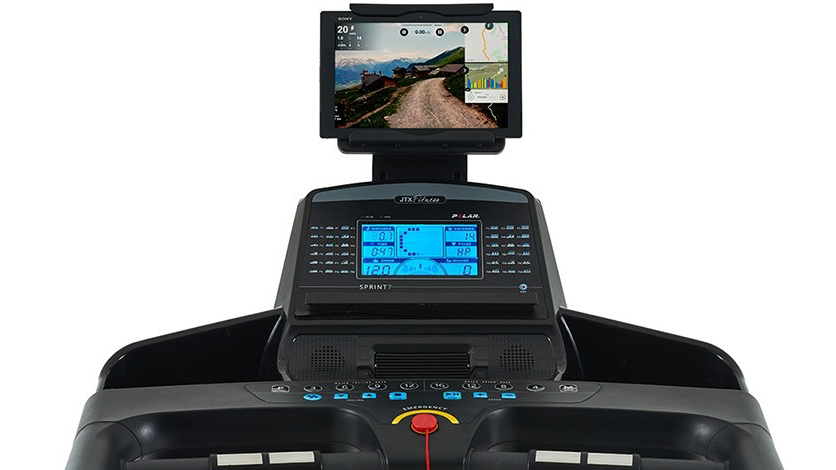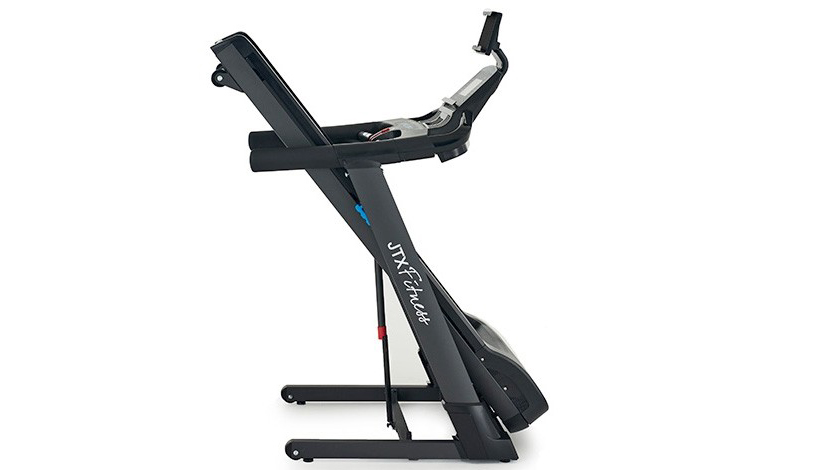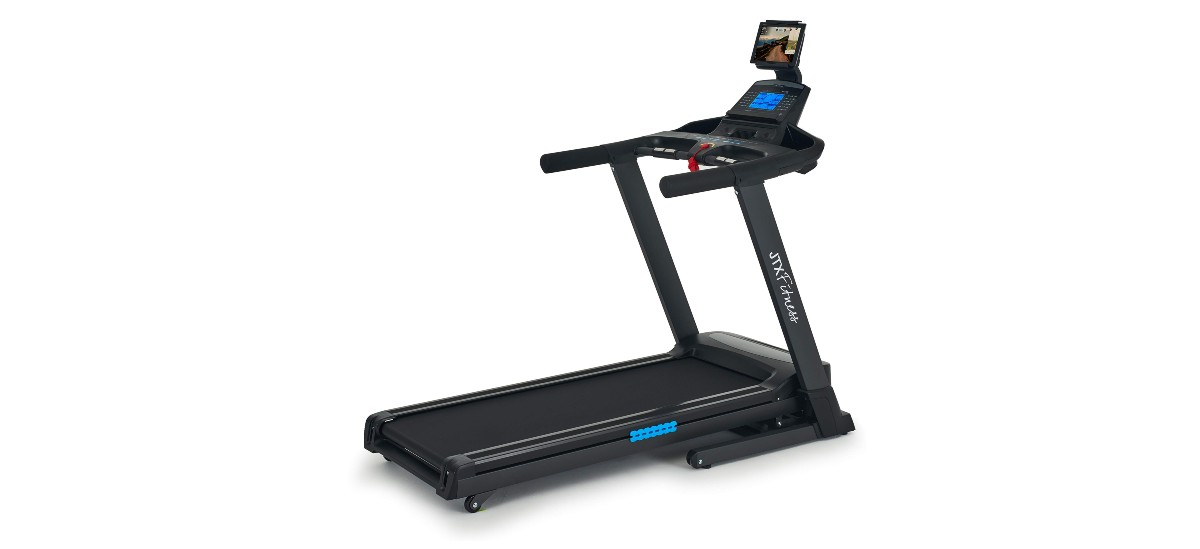Our Verdict
There’s little to fault about the Sprint-7 at its price, with its specs matching up well with gym-standard treadmills that cost twice as much. It’s easy to use, has a powerful motor and a high enough top speed for the vast majority of runners.
For
- Powerful 3HP motor
- High max speed and incline
- Connects to Kinomap app
Against
- No Zwift connectivity
You can trust Coach
Buying a home treadmill is an expensive business. Unlike exercise bikes and rowing machines, you can’t really replicate the experience you get in a gym for less than £1,000. However, you can get very close to it with the JTX Sprint-7. It might lack a few of the fancy extra features present on premium treadmills, but it nails the basics and will satisfy runners of all levels.
I consider myself to be an experienced runner, running every day with six marathons under my belt, and under current conditions I’ve been able to log lots of miles on its belt.
The machine has a top speed of 20km/h (12.4mph), not as high as some top-end machines but enough to satisfy the vast majority of runners. Crucially, the Sprint-7 has a powerful 3HP motor, which means that even when working at the top of its range, the belt runs smoothly. That isn’t always the case with advertised top speeds if the motor is too weak to back them up, but I logged long stints at 16-17km/h on the Sprint-7 without ever feeling like I was stretching its limits.
It’s not particularly quiet, hitting around 70 decibels as standard during my runs, so you’re probably not going to make any friends if you live in a block of flats with thin walls. But it’s not considerably louder than other treadmills, and this is something you’ll have to take into account if your heart is set on a home cardio machine.
The console display is pretty standard, showing the key stats on your run with a virtual track running around the main screen so you can watch your run fly by in 400m chunks. I found this oddly captivating – even when I had linked a footpod to training app Zwift to run in its immersive virtual worlds, I’d keep checking on my progress in the current 400m chunk.
There are quick speed and inline buttons on the machine that you can use to hit certain levels without having to hold the up or down buttons. These are very useful in interval workouts when you don’t want to hold down a button while trying to maintain your sprint speed.

The machine is loaded with 36 preset workouts, which are all displayed either side of the screen in tiny graphics that show how the speed and incline will change throughout. It’s not the easiest way to browse and decide on a workout. You select the one you want by pressing the P button until the number of your session comes up. All the workouts default to a duration of 30 minutes, but this can be adjusted to anywhere from five to 99 minutes using the speed buttons before you start.
You don’t get a larger, more readable version of the workout on the display once it’s started, or even a prompt as to what’s next in the session. You have to squint at the tiny image of the workout breakdown to try to see if the speed or incline is about to change.
If you use a Bluetooth heart rate monitor the treadmill will connect to that to display your heart rate on screen and it did this automatically with the Polar belt I use. You can then set workouts based on your heart rate, creating a target zone on the machine, which will automatically adjust the speed and incline to keep you in that zone. Setting this up is a bit of a faff, though – it’s easier to keep tabs on your heart rate and change the levels yourself.
It all makes for a decent range of workouts and although the way they’re implemented leaves a little to be desired, if you’re looking to mix up your training you can pick one pretty much at random and be assured you’ll get a tough session. You can also set a simple target using the M button before starting your run, whether that’s a time, distance or calorie goal.
The treadmill itself requires very little technical expertise to assemble – there aren’t very many parts and they just need to be screwed together. However, step one is getting the base out of the box and in position, and it’s very heavy. I just about managed to do it solo, but what would have been an easy one-minute job with two people took 15 minutes of sweating and swearing by myself. Get someone to help you assemble it, is what I’m saying.
The machine comes with a bottle of lubricant, which you are advised to use every three months. That and keep it clean – not a particularly onerous task but one that’s vital to keeping the belt running smoothly in the long term. The Sprint-7 also has a three-year in-home repair warranty.
The 145cm by 51cm belt is spacious enough to accommodate taller runners – I’m 6ft (182cm) and found I could run comfortably on the belt without any fears of tumbling off the back. The folding system is handy for reducing the room the machine takes up, but it is still pretty large even when you do bring the belt up to the console. Once folded you can wheel the machine around fairly easily and tuck it into a corner at least.

With pricier treadmills you get extra features like flashier consoles or connectivity to a range of apps. Although the Sprint-7 can connect to the Kinomap app to follow routes and workouts uploaded by other app users on a tablet or phone – the machine comes with a tablet holder you can attach to the console – it doesn’t really excel on this front. The free version of Kinomap doesn’t have a vast amount of content and it’s less engaging than using something like Zwift or just streaming something on a tablet.
However, not excelling when it comes to those kinds of frills is hardly a reason to criticise a machine at this price. It matches up well with top treadmills when it comes to the essentials – running smoothly at high paces, with a solid interval range and a decent array of preset workouts to try. If you’re a runner of any level looking for a well-priced treadmill that will last you even when using it regularly at high speeds, the Sprint-7 should be top of your list.

Nick Harris-Fry is a journalist who has been covering health and fitness since 2015. Nick is an avid runner, covering 70-110km a week, which gives him ample opportunity to test a wide range of running shoes and running gear. He is also the chief tester for fitness trackers and running watches, treadmills and exercise bikes, and workout headphones.


